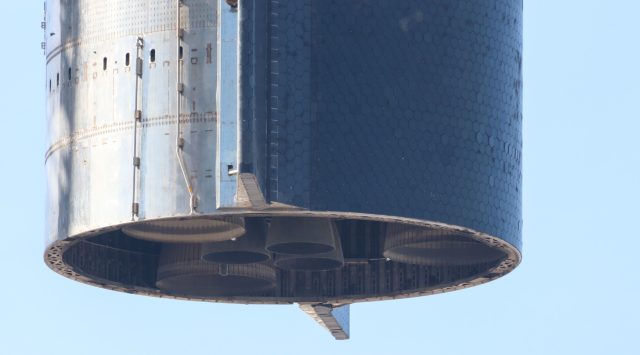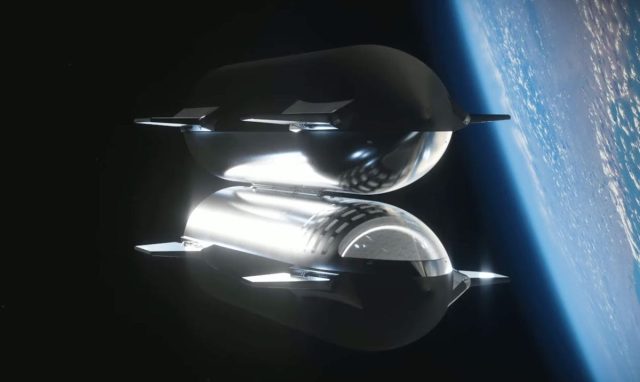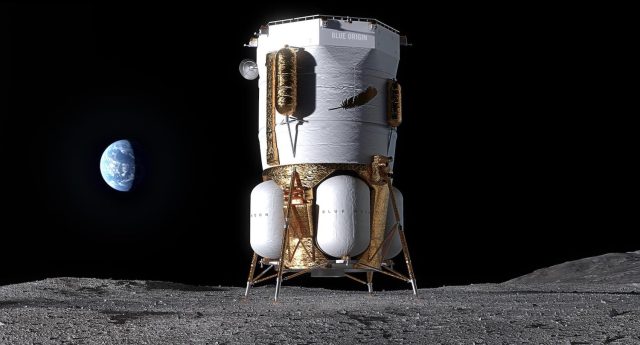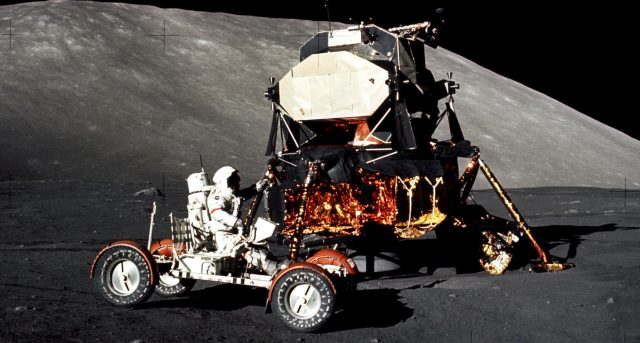SpaceX
NASA managers are in South Texas this weekend as SpaceX prepares to launch its second full-sized Starship rocket. If the rocket flies perfectly, it will unlock additional tests beginning as soon as next year to prove that SpaceX can transfer hundreds of tons of super-chilled methane and liquid oxygen between two spaceships in orbit.
This is a fundamental part of the architecture SpaceX has designed to fly Starship missions beyond low-Earth orbit. With two NASA fixed-price contracts valued at more than $4 billion, SpaceX is on the hook to develop and fly two human-rated lunar landers based on the Starship design (and likely many more missions, assuming these first two work as advertised).
Depending on who you ask, SpaceX may need to launch a dozen or more refueling tankers to fill up the methane and liquid oxygen tanks on the Starship lunar lander, which will have emptied its tanks just to get into low-Earth orbit following launch on top of a Super Heavy booster. The Starship lander will use this fuel to boost itself out of low-Earth orbit toward the Moon, descend to the lunar surface with astronauts, and climb back into space to deliver the crew to their Earth return vehicle—an Orion spacecraft.
But first, SpaceX needs to get Starship into space. That’s the goal for Saturday with the second test flight of the full-scale Super Heavy rocket and the Starship upper stage. If all goes according to plan, Starship will accelerate to nearly 17,000 mph, just shy of the velocity required to reach a stable orbit around Earth. That will leave the vehicle on a trajectory to naturally re-enter the atmosphere for a targeted splashdown near Hawaii, following a trip most of the way around the world.
The Starship upper stage, in the end, will evolve into multiple designs, creating a fleet of landers, space transporters, refueling tankers, and propellant depots. It’s a bold bet on the future of space exploration.
Unlocking the future
“Tomorrow is a test and we’re going to learn a lot either way,” Lisa Watson-Morgan, who manages NASA’s Human Landing System program, told Ars in an interview this week. “We’d love to see it go off perfectly, but frankly, if it doesn’t, it’s still going to be a great learning event, and it still will give us progression on the schedule for the different flight tests, and then we’ll know the areas we need to more deeply penetrate.”
Despite different cultures, NASA—the often-bureaucratic and conservative government agency—and SpaceX—the fast-moving company that likes to design, break, and fix things—are tied at the hip. Without SpaceX, US astronauts would still be totally reliant on Russian to fly to the International Space Station. Without NASA support, SpaceX probably wouldn’t be here today.
NASA officials have said that their cooperation with SpaceX in developing the Crew Dragon spacecraft for space station ferry flights has laid a foundation for their newer partnership on the Starship lander, which will be NASA’s first Human Landing System, a critical piece of the agency’s Artemis program to return astronauts to the Moon.
“The Starship that will be tested (Saturday) is clearly not as mature as the Human Landing System Starship that we will eventually have,” Watson-Morgan said. “It is a precursor or early demonstration.”
There is a roadmap for SpaceX to quickly mature Starship, introducing new technology and capabilities over a series of test flights set to run through 2024. The big priorities for Starship are to move forward with iterating the design to support NASA’s lunar lander needs and to start deploying new-generation Starlink Internet satellites, allowing SpaceX to grow the broadband network significantly faster than possible with its existing Falcon 9 rockets.
How quickly SpaceX makes progress with Starship hinges on a lot of things. At the top of that list is the result of the Starship test flight set to take off Saturday from Cameron County, Texas. SpaceX has a 20-minute launch window opening at 7 am CST (13:00 UTC).
Ars has covered all the upgrades and changes that SpaceX made since the first test flight of the nearly 400-foot-tall rocket back in April. Watson-Morgan said that NASA engineers will be watching how everything performs for the next test launch. This includes the modified launch pad, the 33 Raptor engines on the Super Heavy booster and six more on the Starship upper stage, the flight software, guidance, navigation, and control, and the new “hot staging” technique SpaceX will try out on the second test flight.

“All the engineering disciplines, all the functional systems that you would expect, the NASA team gets insight into that and then from that we can see how their system, their design and development, how it’s maturing,” Watson-Morgan said. “We do provide feedback and our experience base if we see things.”
At least five of the booster’s 33 Raptor engines failed on the first Starship test flight earlier this year. After analyzing data from that flight, engineers discovered there were fuel leaks that led to fires in the booster engine compartment. The Raptor engines, each burning methane fuel and producing about a half-million pounds of thrust, need to be a lot more reliable for SpaceX to move on to in-orbit refueling tests and Starlink launches using Starship, not to mention meeting NASA’s stringent safety standards for astronauts.
“We do anticipate the Raptor engines will perform better for this test,” Watson-Morgan told Ars. The engines on the next Starship test flight are a mixture of first- and second-generation Raptors, whereas the first launch in April primarily used the older engine model.
“By the time of the Human Landing System Starship, we will be on a much later generation of Raptor, thereby having the predictability of the engines that is required for human-rating of the Starship itself,” Watson-Morgan said.
Everyone wants to know, but no one knows
There are a lot of unanswered questions about what it will take to send Starship to the Moon, but the basic outline of the architecture is there. SpaceX will launch a Starship depot into orbit a few hundred miles above Earth, where it will loiter to await delivery of fresh methane and liquid oxygen from a wave of Starship tankers.
The depot will have consumed its original supply of 1,200 metric tons (or more) of propellant just to get into orbit. The Starship tankers will substitute extra fuel capacity for the ability to carry 150 metric tons, or more, of cargo to low-Earth orbit, allowing each tanker to dock with the depot and gradually fill its tanks.
At some point during this sequence, which will play out over the course of several weeks to several months, SpaceX will launch the human-rated lander version of Starship without anyone onboard. Once the depot is at full capacity, Starship will dock with it, receive a fresh supply of methane and liquid oxygen, then light its Raptor engines for the journey to the Moon.
All of these will launch on top of the Super Heavy booster, likely alternating between launch pads in Texas and Florida.
But there are a lot of unknowns. Can two Starships safely link up and connect their propellant transfer lines in orbit? The answer to this is probably yes. SpaceX has plenty of experience with this technology in docking its Dragon spaceships to the International Space Station.
How quickly will cryogenic methane and liquid oxygen boil off in orbit? This is not as easy to know until SpaceX gathers data on the thermal behavior of these liquids, each stored hundreds of degrees below zero, after loitering for weeks to months in space. During this time, the Starship depot will be exposed to extreme temperature swings as it flies between the day and night side of Earth. Small temperature fluctuations inside the tanks can cause methane and liquid oxygen to boil off, or transition from a liquid to a gas, and be lost.
How efficiently can SpaceX actually transfer propellants in microgravity? Will any propellant be lost during the transfer? Engineers need flight tests and demonstrations to know the final answer to these questions, and when those tests happen hinges on the outcome of this weekend’s Starship launch.

SpaceX
NASA and SpaceX engineers are working together to analyze “things like ullage, for tank collapse, for slosh, for how the fluids should go from one ship to the other, the guidance navigation and control, how the two ships are going to hold steady,” Watson-Morgan said. “So we are working hand in hand with them, and our experts are performing independent analysis that we’re giving to SpaceX.”
One of the next steps is a flight demonstration “Tipping Point” technology development award SpaceX received from NASA in 2020. At that time, NASA described this $53 million award as a “large-scale flight demonstration to transfer 10 metric tons of cryogenic propellant, specifically liquid oxygen, between tanks on a Starship vehicle.”
“We’re interested in the science that comes from that, and later on next year, we anticipate a propellant transfer demonstration [between two Starships],” Watson-Morgan said. “That’s really when we start maturing the systems, and when it really gets exciting for HLS, because those are the building blocks that we need and, frankly, it’s never been done successfully in orbit.”
“Complex and challenging”
It’s only after a propellant transfer demonstration that SpaceX and NASA can know the answers to some of the long-simmering questions about the Starship lander. One of those questions is the number of tanker launches SpaceX will need just to enable a single Artemis landing mission.
“We have a general idea, but I’m reluctant to say exactly what that is because SpaceX is still designing Starship and the booster and the fleet—the tankers and the depot,” Watson-Morgan said. “That’s why we really need, next year, the propellant transfer demonstration test because that will then help us say, ‘OK, we see the boil-off, we see the sizing, we see how long it takes to transfer this fluid.'”
Watson-Morgan suggested the range in the number of Starship tanker flights for a single Artemis mission could be in the “high single digits to the low double digits.” Elon Musk, SpaceX’s founder and CEO, has suggested the company is looking at expanding Starship’s capacity with larger propellant tanks. This could help reduce the number of tanker flights.
Musk said in June that the switch to a “hot staging” technique for Starship will increase the rocket’s payload capacity, but Watson-Morgan said this won’t affect the HLS program. “With the analysis that we see, and the predictions moving forward, the hot staging shouldn’t impact for us the number of tankers or our concept of operations,” she said.
Lakiesha Hawkins, deputy associate administrator for NASA’s Moon to Mars program office, provided a different number of tanker flights Friday in a meeting of the NASA Advisory Council’s human exploration and operations committee. Hawkins suggested SpaceX will need launches somewhere in the “high teens” for an Artemis landing mission, with those flights lifting off from Texas and Florida about once every six days.
“In order to be able to meet the schedule that is required, as well as managing boil-off and so forth with the fuel, there’s going to be a rapid succession of launches with fuel,” Hawkins said, adding that this approach is “complex and challenging.”

Blue Origin
In a 2021 report, the Government Accountability Office wrote that SpaceX needed 16 launches to support a single human landing mission. Musk wrote on social media around the same time that such a high number was unlikely. He suggested a maximum of eight tanker flights to refuel a lunar-bound Starship in low-Earth orbit—and possibly as few as four.
That doesn’t appear to be a number NASA is counting on for Artemis III. “It really depends on tank stretching, tank sizes, how long they have to loiter,” Watson-Morgan said.
The Starship depot will linger in low-Earth orbit as tankers arrive one by one. Then, once the Starship lander reaches its orbit around the Moon, it will have to wait for arrival of astronauts flying from Earth on NASA’s Space Launch System rocket and Orion capsule.
“So there’s that orchestration,” Watson-Morgan said. “That’s why I say it’s dependent on many things, and right now we’re really just focusing on getting to orbit and fully understanding the fluid dynamics associated with the prop transfer, which will be an amazing engineering feat and one that hasn’t been done yet.
“Depending on how all that goes, then we’ll determine the right steps for the uncrewed demo and move forward from there,” she said. SpaceX and NASA plan to launch a Starship to the Moon for an unpiloted end-to-end demonstration before committing to use Starship for the crew lunar landing on the Artemis III mission.
Not Apollo 2.0
Artemis II, scheduled to launch in late 2024 or more likely in 2025, will be the first flight of astronauts on the SLS rocket and Orion spacecraft, following a highly successful unpiloted test flight one year ago. Artemis III is officially penciled in for late 2025 on NASA’s schedule, but this will undoubtedly slip, probably by multiple years.
Starship’s readiness is one of the main factors that will determine when Artemis III flies, but there are other challenges. Axiom Space is developing new spacesuits for the astronauts to wear on the lunar surface, and the Orion spacecraft will fly with a docking port for the first time on Artemis III. Although the SLS rocket has flown before, the manufacturer of its core stage, Boeing, hasn’t proved it can deliver on time.
“Yes, the lander is absolutely important. We can’t go anywhere without it. But we also can’t go anywhere without the suits,” said Jim Free, NASA’s associate administrator for exploration systems development, in Friday’s advisory council meeting.
In May, NASA selected Blue Origin to develop a second human-rated lander. SpaceX is on contract for the Artemis III and Artemis IV landers, and Blue Origin will handle Artemis V. The companies will compete for contracts for downstream Artemis missions.
Blue Origin’s lander concept also requires multiple launches to deliver the lander to the Moon and fill it up with propellant, although not as many as SpaceX’s larger Starship vehicle.
It may look like this is all unnecessary given that NASA launched the Apollo lunar lander on the same Saturn V rocket as the crew-carrying Apollo command module. The next version of the SLS rocket, the “Block 1B” variant planned to debut in the late 2020s, will be able to send almost as much payload to the Moon as the Saturn V.
But we know the Space Launch System is expendable and expensive. A single SLS Block 1B rocket will cost at least $2.5 billion to produce, NASA’s inspector recently reported. Relying on this rocket for everything would cripple NASA’s space exploration program.
And the Apollo lunar module never stayed on the lunar surface with a crew for more than three days. On its first flight, the Starship lander will stay on the Moon for six-and-a-half days, and its endurance will grow on subsequent missions. In order to do more than repeat Apollo, NASA and its contractors need to take on new challenges.

NASA/Harrison Schmitt
“This is not Apollo 2.0,” Hawkins said. “We are looking to move as quickly as we possibly can, but we are also establishing an ecosystem there on the surface of the Moon, and hence not only the more complex approach to the landing system, but all the of the elements that are supporting Artemis, to include the Gateway station, as well as the surface assets (like rovers and habitats) that we are placing on the Moon.”
NASA’s overall strategy remains pointed toward sending people to Mars. The Moon missions are an appetizer, offering a chance for practice and technology development in Earth’s neighborhood. NASA recently completed an architecture review for future human exploration of Mars, but those plans are even murkier than the details for getting Starship to the Moon.
Nevertheless, NASA sees the Artemis lunar missions, while historic and challenging on their own, as just a stepping stone. A human mission to Mars will likely need things like in-space refueling, propellant depots, and advanced propulsion and life support. Those are all part of Artemis.
“We’re definitely trying not to be shortsighted about this,” Hawkins said.

Robert Johnson is a UK-based business writer specializing in finance and entrepreneurship. With an eye for market trends and a keen interest in the corporate world, he offers readers valuable insights into business developments.








